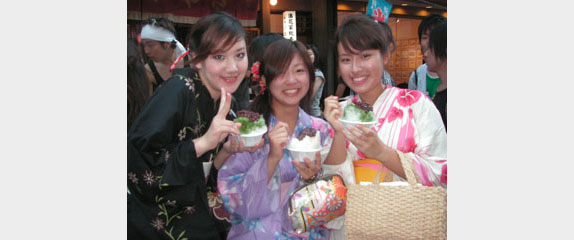Dress-up season in TokyoSummer spawns celebrations of season and spirits
TOKYO — The passion in Japanese souls is never more evident than at a “matsuri” — a festival that is part Mardi Gras, part history lesson, and part food festival.
From local neighborhood fetes to large-scale city events, matsuri celebrate everything from rites of passage to changing seasons to local culture. They even are used to give thanks and help purge sins. Often associated with local shrines and temples, matsuri can last two to three days.
Dancing, archery, drum performances, and other traditional arts, as well as open-air food and game stalls can be part of the celebrations. The centerpiece of many festivals is a parade-like event in which portable shrines, called “omikoshi,” are hauled about on the shoulders of men — and sometimes women — dressed in dashing outfits.
During the summer, Tokyo is one big dress-up party. The trains are loaded with women dressed in colorful “yukata,” cotton summer -weight kimonos, and men in their “jimbei ,” or fancy pajamas. All are headed to the festivals and their wooden sandals make a slap-clapping sound on the pavement.
Not merely a colorful accessory, but a necessity, the “uchiwa,” summer fan, completes the outfit. They are handed out on street corners by merchants and local officials to help keep the crowds cool.
On a sizzling August evening at the Azabu Jyuban Summer Night Festival, the main attractions are the miles of open-air stalls selling favorite Japanese snack foods. Men and women hawk their wares, vying for the attention of the hungry crowd. Each booth is devoted to a single food — and each is a delight.
There is “tako yaki,” morsels of octopus in batter, cooked in a cast iron griddle of half-circles. Once the batter is set, the balls are turned using a long pick and a flick of the wrist before they are sprinkled with shaved seaweed. “Yaki soba” are fried noodles tossed with shreds of vegetables, meat, and ginger heaped onto plates. Next door, there are enormous round potatoes steamed in a stack of wooden boxes, served with a scandalous amount of butter. To beat the heat, there is “kaki gori,” a mountain of shaved ice infused with neon-colored fruit syrup. Roasted “ayu,” river trout, salted and cooked over charcoal, are presented on skewers; their aroma is irresistible. And the all-time favorite, “okonomi-yaki,” is a savory pancake fiilled with shredded cabbage, pickled ginger, and slathered with piquant sauces.
Interspersed among the food booths are carnival-like games of chance. Boys and girls with strainers made of paper squat next to troughs of water trying to scoop up goldfish or little rubber balls . It’s not easy to do either before the strainer dissolves.
Follow the sound of drums through the thick crowd to a park on a side street. Glowing lanterns light the grounds where a local group is performing on “taiko” drums. Their beat is primal and relentless. Nearby everyone is invited to join the folk dances. Dancers move as one, in a circle, to a story told in song and movements.
Later in the festival season, on a sweltering day in early autumn, the voices of revelers rise in unison at the Hakusan Harvest Festival in downtown Tokyo. Intermittent sounds of a leader’s whistle punctuate their cries. The deep boom of a large drum trails the omikoshi, providing the cadence that slowly propels the bearers’ syncopated shuffle forward.
Prior to the parade, the omikoshi are taken out of storage to the local shrine for a blessing that also allows the spirits of the deities residing within to enter before the annual neighborhood walk about. These bearers are members of neighborhood clubs and civic and business associations who gather to care for and carry the omikoshi.
“Wasshoi! Wasshoi!” — “All together! All together!” — is their fervent cry as the marchers make their way though the streets. Their elaborate shrines, gorgeously handcrafted from heavy timber, can be simple or gaudy, but atop each sits a golden phoenix. Lacquered pieces of timber are set crossways through special holes to form the grid that rests on the bearers’ shoulders. No padding here — this isn’t supposed to be easy. Even smaller omikoshi are heavy and need at least 40 bearers, and the larger ones can weigh more than a ton, requiring more than a hundred people surging forward in unison.
Various groups of marchers will relieve others along the route, each group vying to be the most spirited. The festival can actually become quite rambunctious, as the bearers become more focused and more frenzied. Several members of the team guide the omikoshi to stay on course and to keep it from careening into the crowd following along.
As the light begins to fade, the omikoshi is borne back toward the shrine where the gods will reside for the rest of the year. For the final push, a group of particularly brawny and boisterous men take their final turn and hoist the omikoshi high in the air with a huge roar before settling it back down on their shoulders.
By now their shouts are louder and rougher, their pace more feverish. At the base of a slope they stop in a flurry of patterned clapping and chanting. They have reached the entry way to the shrine and slowly , almost dirge-like, creep up the hill and bring the omikoshi to rest under broad gates, where a priest in full garb invites the gods to re enter the shrine.
Aching, but very happy, members of one club gather for a party in an apartment near the shrine. The wife of one of the bearers and her friends have prepared mountains of food, beer, “shouchu,” a potent potato-based alcohol drink, and sake for the men.
Between drinks, an exhausted Yutaka Yamaguchi, 54, a banker and omikoshi bearer for more than 20 years, says he has enjoyed building “harmony with others while having fun.” He and his buddies will travel to more neighborhoods to participate in other festivals where their shoulders are needed.
Sated, but still drinking, the men get louder and looser. They take off their coats and compare the size of their shoulder calluses, jokingly called “tako.”
“Looks like the head of an octopus doesn’t it?” said Yamaguchi. The bumps develop from years of carrying omikoshi and are huge, permanent, and borne with great pride.











 Debra Samuels, bestselling author, food writer and cooking instructor,
Debra Samuels, bestselling author, food writer and cooking instructor, 


